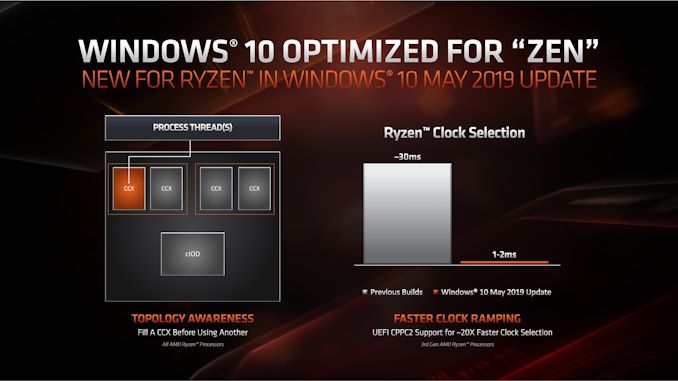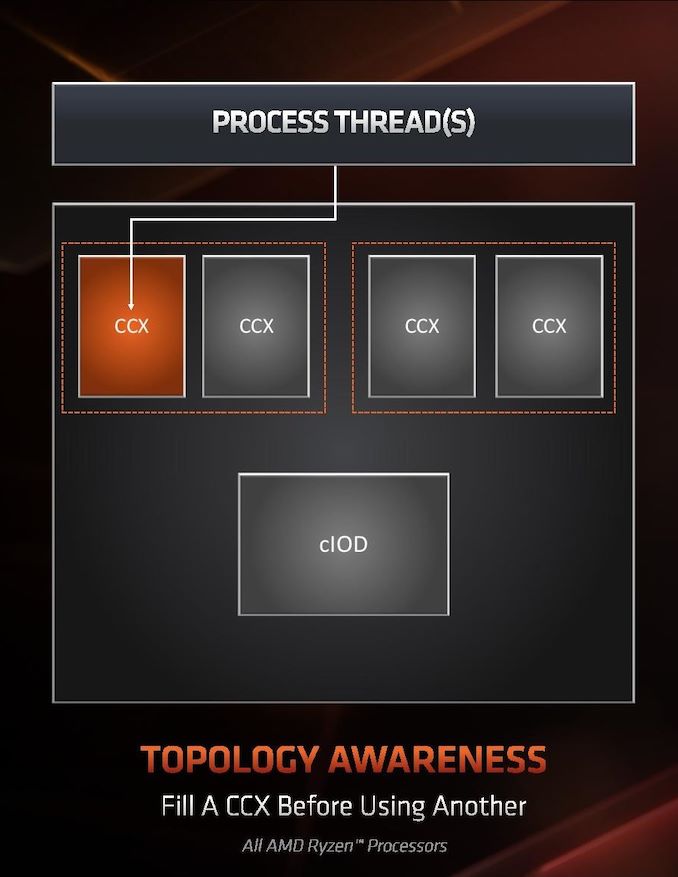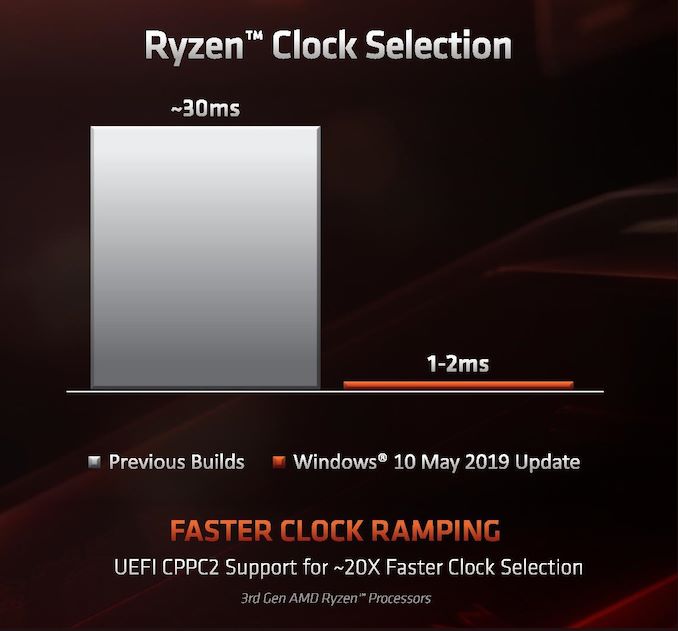The AMD 3rd Gen Ryzen Deep Dive Review: 3700X and 3900X Raising The Bar
by Andrei Frumusanu & Gavin Bonshor on July 7, 2019 9:00 AM ESTSection by Dr. Ian Cutress (Orignal article)
Windows Optimizations
One of the key points that have been a pain in the side of non-Intel processors using Windows has been the optimizations and scheduler arrangements in the operating system. We’ve seen in the past how Windows has not been kind to non-Intel microarchitecture layouts, such as AMD’s previous module design in Bulldozer, the Qualcomm hybrid CPU strategy with Windows on Snapdragon, and more recently with multi-die arrangements on Threadripper that introduce different memory latency domains into consumer computing.
Obviously AMD has a close relationship with Microsoft when it comes down to identifying a non-regular core topology with a processor, and the two companies work towards ensuring that thread and memory assignments, absent of program driven direction, attempt to make the most out of the system. With the May 10th update to Windows, some additional features have been put in place to get the most out of the upcoming Zen 2 microarchitecture and Ryzen 3000 silicon layouts.
The optimizations come on two fronts, both of which are reasonably easy to explain.
Thread Grouping
The first is thread allocation. When a processor has different ‘groups’ of CPU cores, there are different ways in which threads are allocated, all of which have pros and cons. The two extremes for thread allocation come down to thread grouping and thread expansion.
Thread grouping is where as new threads are spawned, they will be allocated onto cores directly next to cores that already have threads. This keeps the threads close together, for thread-to-thread communication, however it can create regions of high power density, especially when there are many cores on the processor but only a couple are active.
Thread expansion is where cores are placed as far away from each other as possible. In AMD’s case, this would mean a second thread spawning on a different chiplet, or a different core complex/CCX, as far away as possible. This allows the CPU to maintain high performance by not having regions of high power density, typically providing the best turbo performance across multiple threads.
The danger of thread expansion is when a program spawns two threads that end up on different sides of the CPU. In Threadripper, this could even mean that the second thread was on a part of the CPU that had a long memory latency, causing an imbalance in the potential performance between the two threads, even though the cores those threads were on would have been at the higher turbo frequency.
Because of how modern software, and in particular video games, are now spawning multiple threads rather than relying on a single thread, and those threads need to talk to each other, AMD is moving from a hybrid thread expansion technique to a thread grouping technique. This means that one CCX will fill up with threads before another CCX is even accessed. AMD believes that despite the potential for high power density within a chiplet, while the other might be inactive, is still worth it for overall performance.
For Matisse, this should afford a nice improvement for limited thread scenarios, and on the face of the technology, gaming. It will be interesting to see how much of an affect this has on the upcoming EPYC Rome CPUs or future Threadripper designs. The single benchmark AMD provided in its explanation was Rocket League at 1080p Low, which reported a +15% frame rate gain.
Clock Ramping
For any of our users familiar with our Skylake microarchitecture deep dive, you may remember that Intel introduced a new feature called Speed Shift that enabled the processor to adjust between different P-states more freely, as well as ramping from idle to load very quickly – from 100 ms to 40ms in the first version in Skylake, then down to 15 ms with Kaby Lake. It did this by handing P-state control back from the OS to the processor, which reacted based on instruction throughput and request. With Zen 2, AMD is now enabling the same feature.
AMD already has sufficiently more granularity in its frequency adjustments over Intel, allowing for 25 MHz differences rather than 100 MHz differences, however enabling a faster ramp-to-load frequency jump is going to help AMD when it comes to very burst-driven workloads, such as WebXPRT (Intel’s favorite for this sort of demonstration). According to AMD, the way that this has been implemented with Zen 2 will require BIOS updates as well as moving to the Windows May 10th update, but it will reduce frequency ramping from ~30 milliseconds on Zen to ~1-2 milliseconds on Zen 2. It should be noted that this is much faster than the numbers Intel tends to provide.
The technical name for AMD’s implementation involves CPPC2, or Collaborative Power Performance Control 2, and AMD’s metrics state that this can increase burst workloads and also application loading. AMD cites a +6% performance gain in application launch times using PCMark10’s app launch sub-test.
Hardened Security for Zen 2
Another aspect to Zen 2 is AMD’s approach to heightened security requirements of modern processors. As has been reported, a good number of the recent array of side channel exploits do not affect AMD processors, primarily because of how AMD manages its TLB buffers that have always required additional security checks before most of this became an issue. Nonetheless, for the issues to which AMD is vulnerable, it has implemented a full hardware-based security platform for them.
The change here comes for the Speculative Store Bypass, known as Spectre v4, which AMD now has additional hardware to work in conjunction with the OS or virtual memory managers such as hypervisors in order to control. AMD doesn’t expect any performance change from these updates. Newer issues such as Foreshadow and Zombieload do not affect AMD processors.














447 Comments
View All Comments
Korguz - Monday, July 8, 2019 - link
huh ???mkozakewich - Saturday, July 13, 2019 - link
"...as unfortunately the timing didn’t work out."You should increase his voltage a little and reboot, that might help.
Meteor2 - Monday, July 15, 2019 - link
It's hard to get one's head around this, but basically: *all* the Intel benchmarks *do not* include the security patches for the MDS-class flaws. The 9000 and 8000 series tests do include the OS-side Spectre fixes, but that's it. No OS-fixes for other CPUs, and no motherboard firmware fixes for any Intel CPUsAt the very least, all the Intel CPUs should be retested on Windows 10 1903 which has the OS-side MDS fixes.
Most if not all the motherboards used for the Intel reviews can also have their firmware upgraded to fix Spectre and most times MDS flaws. Do it.
This is sensible and reasonable to do: no sensible and reasonable user would leave their OS vulnerable. Maybe the motherboard, because it's a bit scary to do, but as that can be patched, it should be by reviewers.
This would result in all the Intel scores being lower. We don't know by how much without this process actually being done. But until it is, the Intel results, and thus the review itself, are invalid.
While you're at it Anandtech, each year buy the latest $999 GPU for CPU testing. Consider it a cost of doing business. Letting the GPU bottleneck the CPU on most game resolutions benchmarked is pointless.
plonk420 - Sunday, July 7, 2019 - link
mountain time zone, best time zone... 7am 7/7!exactopposite - Sunday, July 7, 2019 - link
Been waiting on this one for a long timeEris_Floralia - Sunday, July 7, 2019 - link
It's really nice to see Andrei starting to take part in desktop processor reviews and Gavin Bonshor's hardwork!mjz_5 - Sunday, July 7, 2019 - link
Intel gets 5% better FPS In games is really not a win. I’ll consider that a tie. In multiple applications AMD gets 20% more performance. That’s a win!!Dragonstongue - Sunday, July 7, 2019 - link
hopefully Anal lists :P see how much a "win" the Ryzen 3k / x5xx / Navi truly are, not only to get AMD margins even higher but to take more market share from Intel and "stagnate" Nvidia's needing to "up the price" to make more $$$$$$ when AMD "seems" to be making "as much if not more" selling a small amount less per unit (keep in mind, AMD is next Playstation and Xbox which are 99/9% likely to be using the same silicon, so, AMD take a "small hit" to get as many Ryzen gen 3 and Navi "in the world" which drums up market/mindshare which is extremely important for any business, at this stage in the game is VITAL for AMD.sor - Sunday, July 7, 2019 - link
I’m honestly wondering what the point is of the gaming benchmarks for CPU tests anymore.It seems like the game is either so easy to render that we are comparing values in the hundreds of FPS, or they’re so hard to render that it’s completely GPU dependent and the graph is flat for all CPUs.
In the vast majority of tests here one would have an identical experience with any of the top four CPUs tested.
Targon - Monday, July 8, 2019 - link
Game engines are starting to use more cores, and at lower resolutions(which do not stress the video card all that much) will show improvements/benefits of using one CPU or even platform over another. In this review, due to the RAM being used, the gaming benchmarks are almost invalid(DDR4-3200 CL16), since moving to CL14 RAM would potentially eliminate any advantage Intel has in these benchmarks.